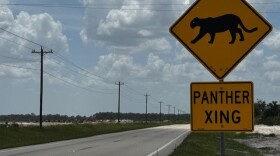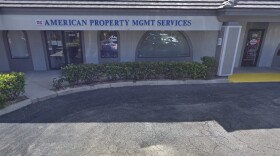Several Southwest Florida municipalities have banned outdoor burning for the second time this year, fearing the ongoing drought -- fueled by above-average temperatures and below-normal rainfall -- has parched the forests and primed them for wildfire.
Sarasota County declared a burn ban for unincorporated parts of the county and the City of Sarasota more than a month ago. Manatee County and North Port activated burn bans last week.
Southwest Florida’s drought has returned to Sarasota and Manatee counties along with the Tampa Bay region, according to the U.S. Drought Monitor.
It rained just enough this summer to quench the parched soil for a time, but South Florida’s rainy season didn’t deliver. Fort Myers had more than a foot less rain than is typical during the summer storm season.
More/related stories
- Wildfire season is smoldering; what happens next is up in the air
- Wildfire, burn bans, continue to spread in Southwest Florida
- Warm temperatures in store after heat dome parked over worst drought in Florida in 25 years
- Southwest Florida continues to be among driest areas in state
- Forestry managers concerned about heightened threat of wildfires in South Florida
- Wildfire threat grows as Florida drought gets steadily worse
- Drought, loosening grip on Sunshine State, has not let go of Southwest Florida
- Drought's slow decimation poised to worsen in South Florida in coming decades
The drought that began in February is already the worst in more than two decades, peaking in late July when a “heat dome” of high-pressure over hot air parked over the state. Among a slew of highest-temperature records to fall this summer were in Fort Myers, where May became the fifth-hottest, and in Venice where July became the fifth-hottest.
The rest of Florida’s Gulf-side peninsula is now listed as “abnormally dry,” which is one stage below official drought. Add the dry Panhandle counties and NOAA reports that nearly 70 percent of Florida is just below drought stage.
North Port fire officials decided to back an unusually early burn ban after a spate of wildfires, one that burned quickly due to the exceptionally dry woods and almost got out-of-control.
"I can't remember the last time that we instituted a burn ban this late in the year - or early in the dry season,” depending on which way one wants to look at it, said Scott Lane, North Port’s deputy fire chief. “Usually, we're instituting it around springtime."
Lane, who was speaking to WFTX-TV, added that the conditions are possibly lining up “to be a pretty severe season.”
Difficult concept
Drought is a difficult concept to define.
It's typically described as a prolonged period when there is a lot less rain than normal.
The definition matter less than the results. Drought strains ecosystems, intensifies social inequalities, cause mental health stress, disrupt industrial processes, and can contribute to political instability. Drought extends beyond the obvious water shortages and affects food security, economic stability, social cohesion, and environmental health.
Drought is also patient.
Hurricanes whip in and whip out within days. Wildfires blaze high and are put down in less than a week or two. A spate of flooding can last for a month, maybe six weeks.
Drought can last years and is the third-costliest natural disaster in the country. It can affect 500,000 square miles and cause billions in losses throughout various segments of society. Super-dry conditions have caused a cumulative $365 billion in damages during the last 45 years in inflation-adjusted dollars.
In short: Long-term drought is cumulative.
In fact, the reason why this year’s drought is returning from the first half of the year and not a “new” drought is because of the year’s impotent rainy season.
The Drought Monitor dismisses a rainy stretch, or even a whole season, if the showers temporarily end an official classification of drought, but then when the wet period ends water shortages persist and drought conditions return.
Wildland firefighters use several tools in deciding whether to enact a burn ban, key among them is the Keetch-Byram Drought Index which measures the lack of moisture in the soil. Zero is fully saturated ground; 800 is desert-like. Manatee, Sarasota, and Charlotte counites are above 600 now. Lee and Collier counties are both above 500.
Early onset?
The National Significant Wildland Fire Potential Outlook says unless tropical storms affect Florida this month nearly the entire state could see an early onset of the woodland fire season this winter.
That, in turn, will delay controlled burns, which are small fires set by firefighters to clear out underbrush and avoid a runaway wildfire later on, which could exacerbate the effects of the drought early next year.
The long-term forecasts from NOAA, AccuWeather, and the National Weather Service predict the next three months favor above-normal temperatures and below-normal precipitation across Florida.
The winter outlook released by the Climate Prediction Center shows a classic but weak La Niña pattern is most likely, with warmer-than-normal and drier-than-normal conditions likely.
The weather agencies’ forecasts call for rainless days to exacerbate dry conditions at least through February, including in Charlotte, Lee, and Collier counties.
“It’s been a very dry season,” said Jodie Fiske, Manatee County ‘s public safety director. “Our emergency management division regularly talks with our Fire Chiefs Association and (the Florida) Forestry (Service), and they are all in agreement that we needed to enact a burn ban.”
The bans on outdoor burning are until further notice in most place except Manatee County, which may extend its ban later this week if things don’t change really quickly.
“It’s been a very dry season,” said Jodie Fiske, Manatee County ‘s public safety director. “Our emergency management division regularly talks with our Fire Chiefs Association and (the Florida) Forestry (Service), and they are all in agreement that we needed to enact a burn ban.”
Manatee County’s burn ban is similar to the rest:
What's Allowed:
- Grills (both gas and charcoal) remain permitted, though extreme caution is urged
What's Not Allowed:
- Fire pits and cooking pits
- Bonfires and campfires
- Burning yard waste like leaves, branches, and palm fronds
The Sarasota County Fire Department would like to share that the following precautions can protect families and homes from fire danger:
- Create three zones of defensible space around your home or business.
- Clear trash and dead vegetation from the yard.
- Remove leaves and debris from roof, gutters and under decks.
- Have a plan and an emergency preparedness kit packed in case you need to evacuate quickly, especially if your home is near wildlands.
- Monitor local media for updates on road closures, smoke conditions and other hazards.
- Use extreme caution when grilling, camping and discarding cigarettes.
- Don’t use anything, like lawn mowers that may create sparks outside on dry, windy days.
Environmental reporting for WGCU is funded in part by VoLo Foundation, a non-profit with a mission to accelerate change and global impact by supporting science-based climate solutions, enhancing education, and improving health.
Sign up for WGCU's monthly environmental newsletter, the Green Flash, today.
WGCU is your trusted source for news and information in Southwest Florida. We are a nonprofit public service, and your support is more critical than ever. Keep public media strong and donate now. Thank you.








